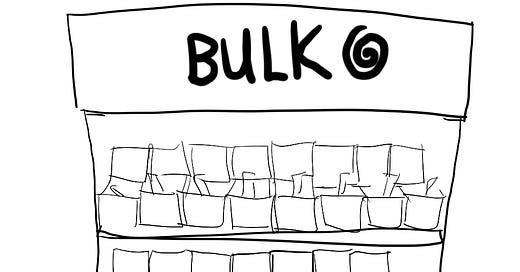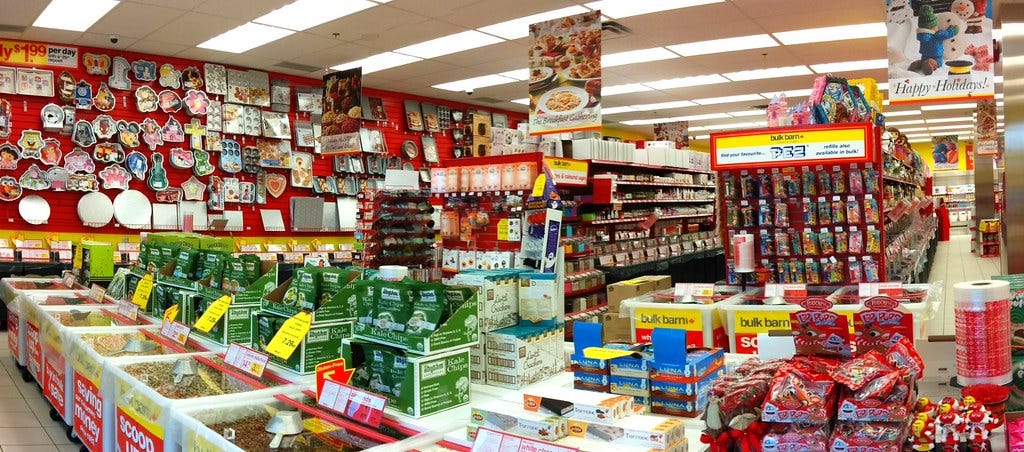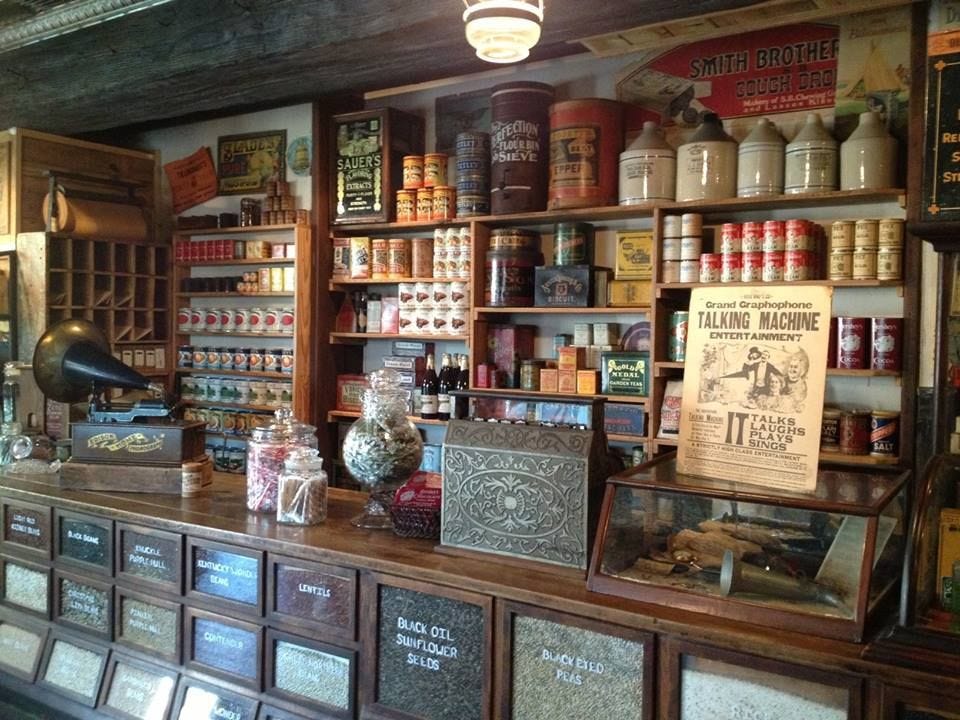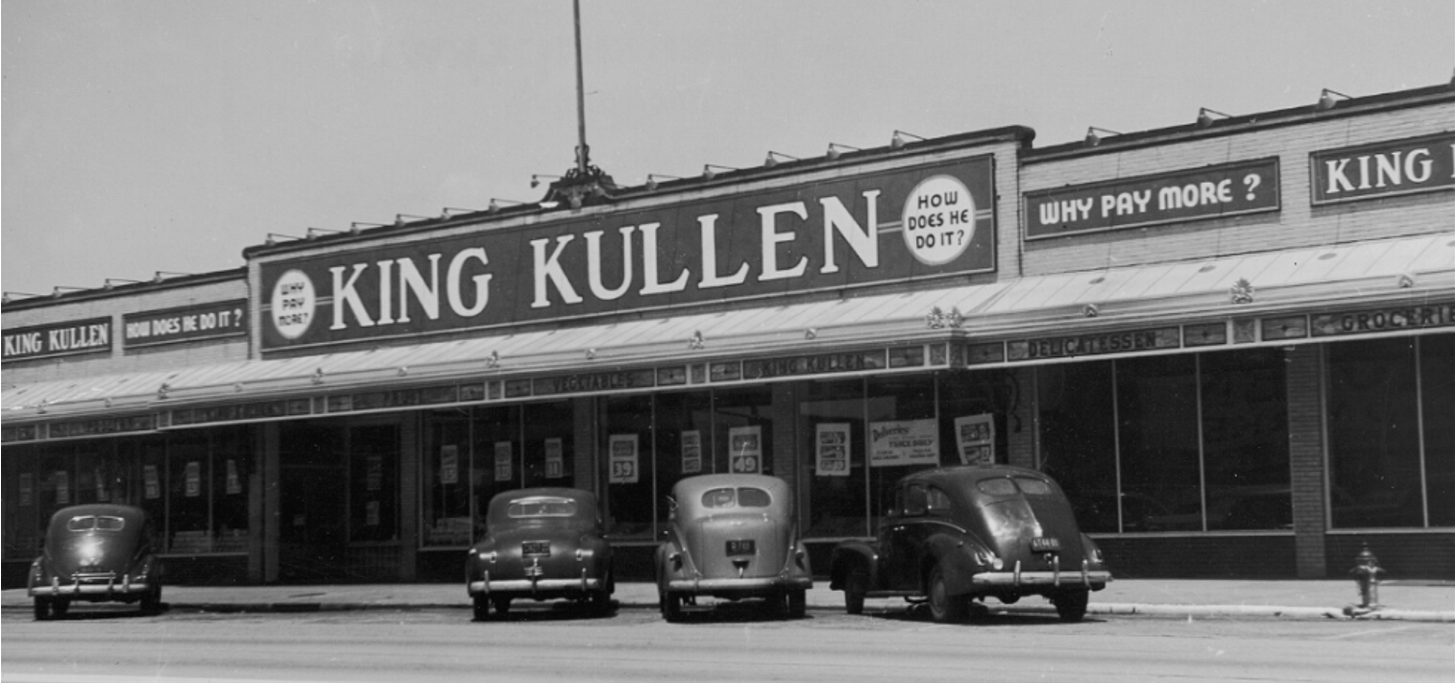Welcome to all of our new subscribers this week. When I decided to write about crosswords, it was to appease my wife - I did not think it would be such a popular topic! Thanks to everyone who forwarded the issue to a friend.
This week I was deep in the aisles of my local bulk store when, out of nowhere, a random woman looked me dead in the eyes and said “This store should be illegal!” then walked away. Illegal because it is so good? Was she concerned about the hygiene of it all? I was a little stunned and took a look around.
I was in a “Bulk Barn,” a Canadian chain of bulk stores that carry everything from Mac and Cheese powder to teff flour to pinãtas to bird seed and nut butters. It was one of their recently renovated stores, with hundreds of tubs of candy, pet foods, dried fruits, baking products, etc. The shelves above and surrounding the bins are filled with international items and traditional health food fare.
Bulk food stores are stores that buy products in large quantities (bulk) and sell them without packaging. Customers can usually bring their own containers or use what the store provides. Beyond reduced packaging, the idea is a greater variety of dry goods at lower costs through less packaging.
Where did bulk shopping come from? When did its popularity wane (and then rise again)? How has bulk managed the transition to package free and eco-conscious shopping? Is bulk actually cheaper? These are some of the things I wondered…
Design
Bulk stores have a lineage that, in North America, traces back to Dry Goods Stores. These were stores, distinct from hardware or grocery stores, that dealt in grocery items that do not contain liquids. From the 1892 Dictionary of Dry Goods by George S Cole:
The dry goods element is one of the greatest features of our Nation's commercial life, and has undoubtedly done the largest share toward developing our national and industrial prosperity. The dry goods store is found in every village and hamlet, and is the center of trade and barter in all rural communities. In the larger towns and cities the dry goods interest forms one of the most important departments of business, and greatly helps in sustaining all other branches of trade.
Dry goods stores helped expand access to non-perishable items as settlement expanded. In addition to food, they often sold other items such as fabrics and cleaning supplies. In Europe, however, where cities and markets were well established, there was little need for dry goods stores. A quick note about the service experience: Self Service grocery didn’t arrive until 1916 (and still took many years to take off). With dry goods and grocery stores, you would hand a list of items to a clerk and they would fulfill your order. Some present-day bulk stores reverted to this style during COVID, but the standard experience is now one of wandering aisles and aisles of bins and serving yourself.
The decline of dry good stores began in 1930, driven by the King Kullen Grocery Co in Jamaica, Queens. It took advantage of the rise in cars (to help you get larger baskets of groceries home) and refrigeration (to allow them to last longer) and brought grocery, dry goods, a butcher and others under one roof. The practice of the daily market visit and small stores designed for frequent visits were being replaced by these new “super markets.” By the 1970s, dry goods and bulk had been relegated to specialty retail and co-ops.
Innovation
Bulk bins and purchasing has been on the upswing (ignoring a pandemic induced pause). Stores like Trader Joe’s and Whole Foods at the high end, have grown their bulk aisles. More traditional grocery stores have added them. Part of the reason is sustainability, which we will touch on below.
Other major drivers of the growth of bulk are diets that are moving away from processed foods and the internationalization of tastes. Bulk products (like nuts, etc.) become essential when moving away from more processed snack alternatives. As consumers get more exploratory with their tastes, they need new ingredients and spices. A bulk store is the perfect place to get just a pinch of nutmeg or garam masala to see if it is something you want to explore more.
Grocery Dive, an industry publication, suggests that the growth of bulk is because it is fairly high margin and simple to include in stores. As well, it makes customers think that the store is more committed to sustainability and unprocessed foods (key decision points) than stores without bulk sections. Mind games!
I found this article on tech innovation in bulk to contain some illumination. Part of the reasons that bulk aisles do not coexist well with others in the supermarket is their unbranded nature. Supermarkets do not want to risk angering their brand partners (who pay for so much of their marketing) or affect their private label businesses (which are large profit drivers).
Another interesting issue in the growth of bulk stores and aisles is that the majority of bulk bin manufacturing is done by one company, Trade Fixtures. Trade Fixtures is a division of Marmon Retail Solutions, which is a wholly-owned subsidiary of Berkshire Hathaway. Next time you see Warren Buffet, make sure to ask him to make it cheaper for the world to go bulk! A fixture wall of “Gravity Dispensers” costs thousands of dollars more than an equivalent grocery shelving system.
Personally, and controversially, there are some snacks I prefer just-the-right-amount-of-stale that taste best when bought in bulk. Nothing beats the muted crunch of a Ringolo or Hickory Stick that has sat in a bin for a couple days or the extra toothiness of a Jujube that has been exposed to the air.
Cost
The bulk food industry group Bulk is Green says that you can save 89% by buying in bulk. Some less-biased sources, like NPR, have found 56% savings - but it is highly dependent on what you are purchasing. Sprouts Farmers Market, a newish grocery chain with an innovative design, advertises that their bulk options are 15-20% cheaper than their packaged counterparts. Nuts and seeds, however, are more expensive in bulk bins, with almonds being the best deal to buy packaged. I tried to figure out why, I even called some bulk stores directly, but this remains a mystery. If you know why, let us know! The most savings can be obtained by purchasing spices in bulk.
Sustainability
The sustainability lens is where bulk really starts to get exciting. Recently, bulk stores have been reinvented as package-free grocery destinations. All over the world, from Berlin to Mexico City to Toronto to Portland, there is likely a package-free store close by. These stores take the traditional bulk offerings and expand them to include household products, fruit and vegetables, and even dairy. You need to bring reusable containers to shop there. When you walk in you weigh your containers, go fill them around the store and then weigh and pay on your way out.
Buying food in bulk significantly reduces packaging materials and grocery bags going into landfills. Less transportation is required by densely packing items into less delivery trucks. Food waste is also reduced because consumers are purchasing exact needed amounts of foods. According to the U.S. Environmental Protection Agency, containers and packaging make up 30 percent of what we dispose of annually.
I would expect to see package-free being a major driver in the growth of bulk going forward. Who needs even more plastic bags when you already have hundreds of containers lying around your house just waiting to be filled with candy?
Here is a great list of package free and bulk stores.
PS
The ultimate “bulk barn” is the Spice Bazaar in Instanbul, which has been around since 1644. With its vibrant displays of dried goods, it is a must visit in the old city. The bazaar is filled with spices, nuts, Turkish delight and delicacies from all our the world. It is also referred to as the Egyptian market because the annual “Cairo Caravan” would bring spices from Egypt and the taxes charged on those imports paid for the construction of the market. Just make sure to bring a bag with a tight seal so you don’t have a surprise when you unpack.










Love this piece. I shop a lot at Bulk Barn and I love how they have very affordable containers to encourage reusability and sustainability. There's also something really satisfying about being able to walk the aisles, explore the variety of spices, nuts, and snacks they have, and filling out your containers. I don't know what it is but it's fun 😂
Also love the mention of the Istanbul spice bazaar in the end. Before moving to Toronto, I spent my entire life in Lebanon and I used to go to spice markets frequently. The video made me feel really nostalgic.
I'm glad I'm not the only person who likes certain foods a little bit stale. (I truly thought I was!)
I hope the bulk food stores come to my geographical area. I would definitely shop there for staples and use my own containers.